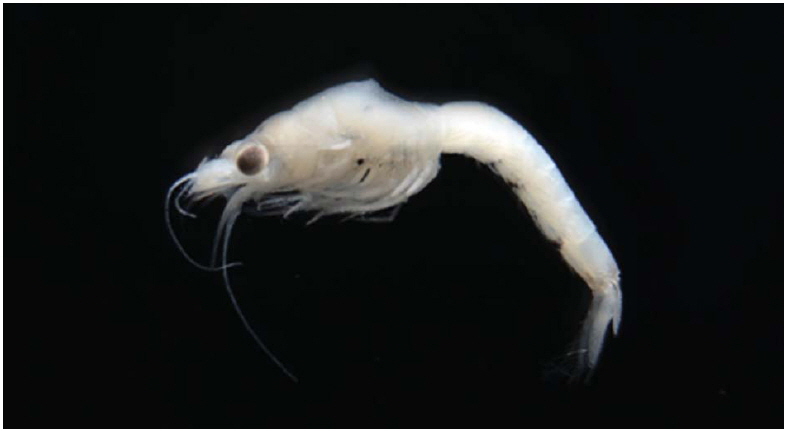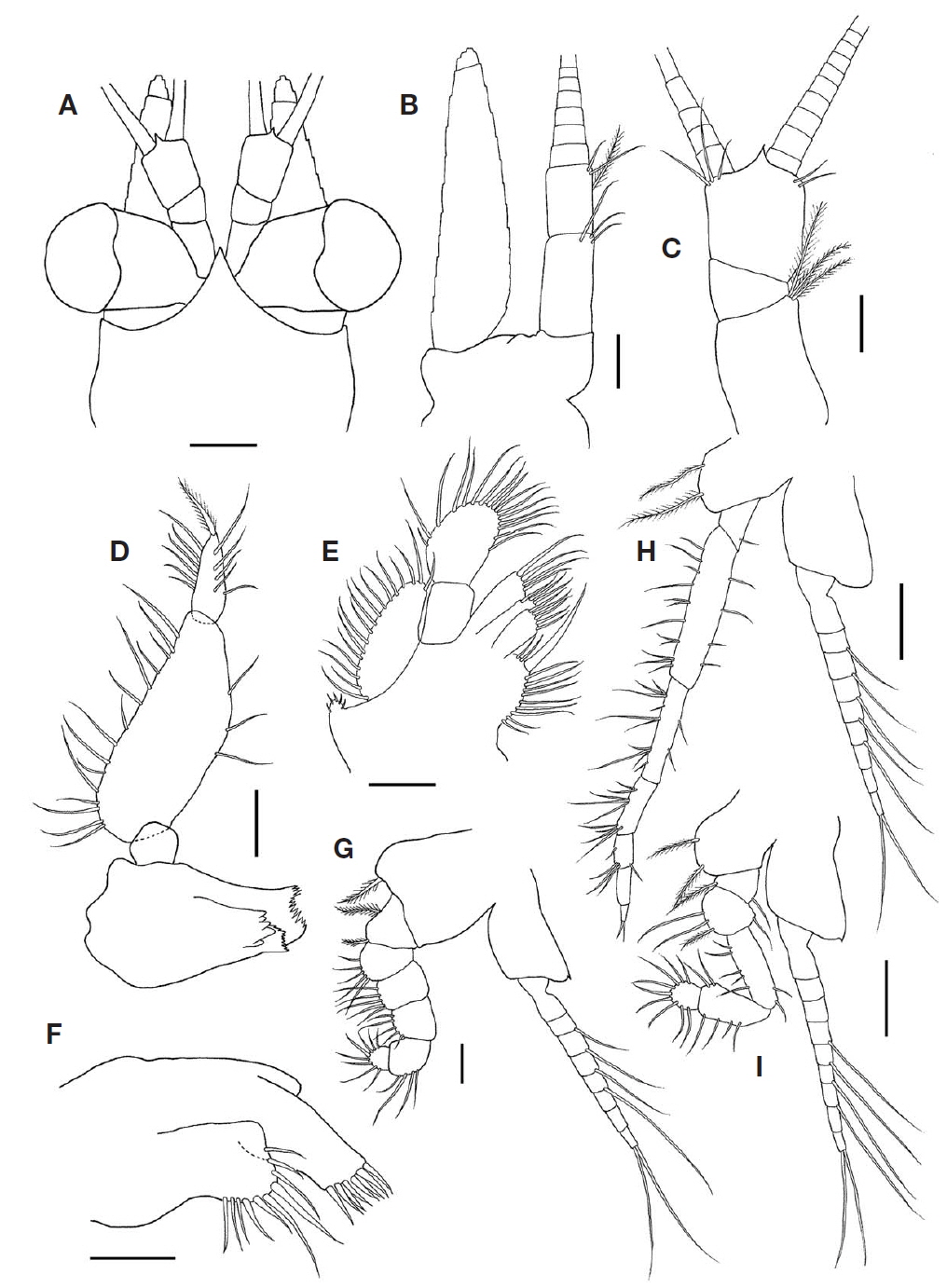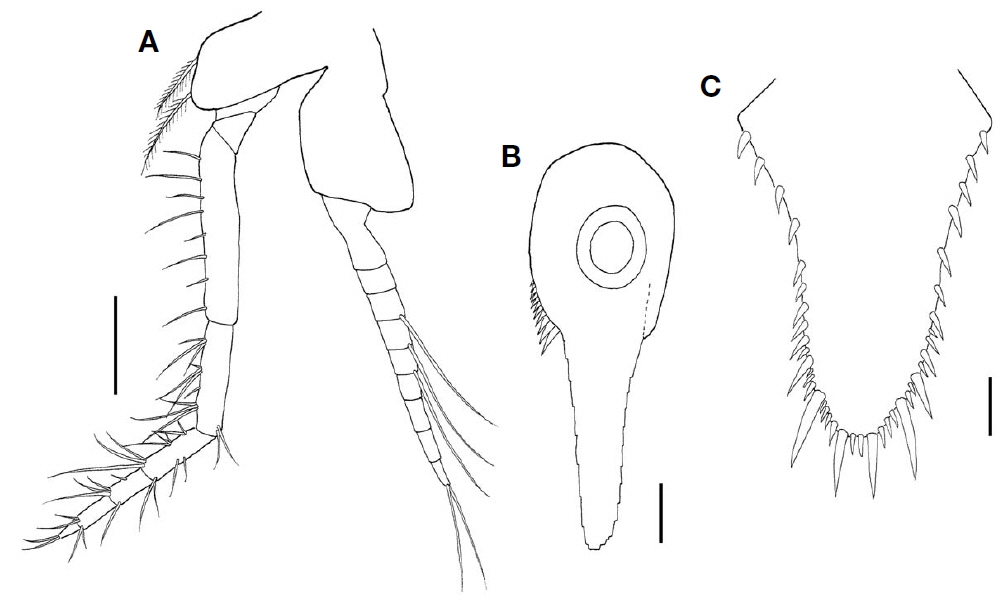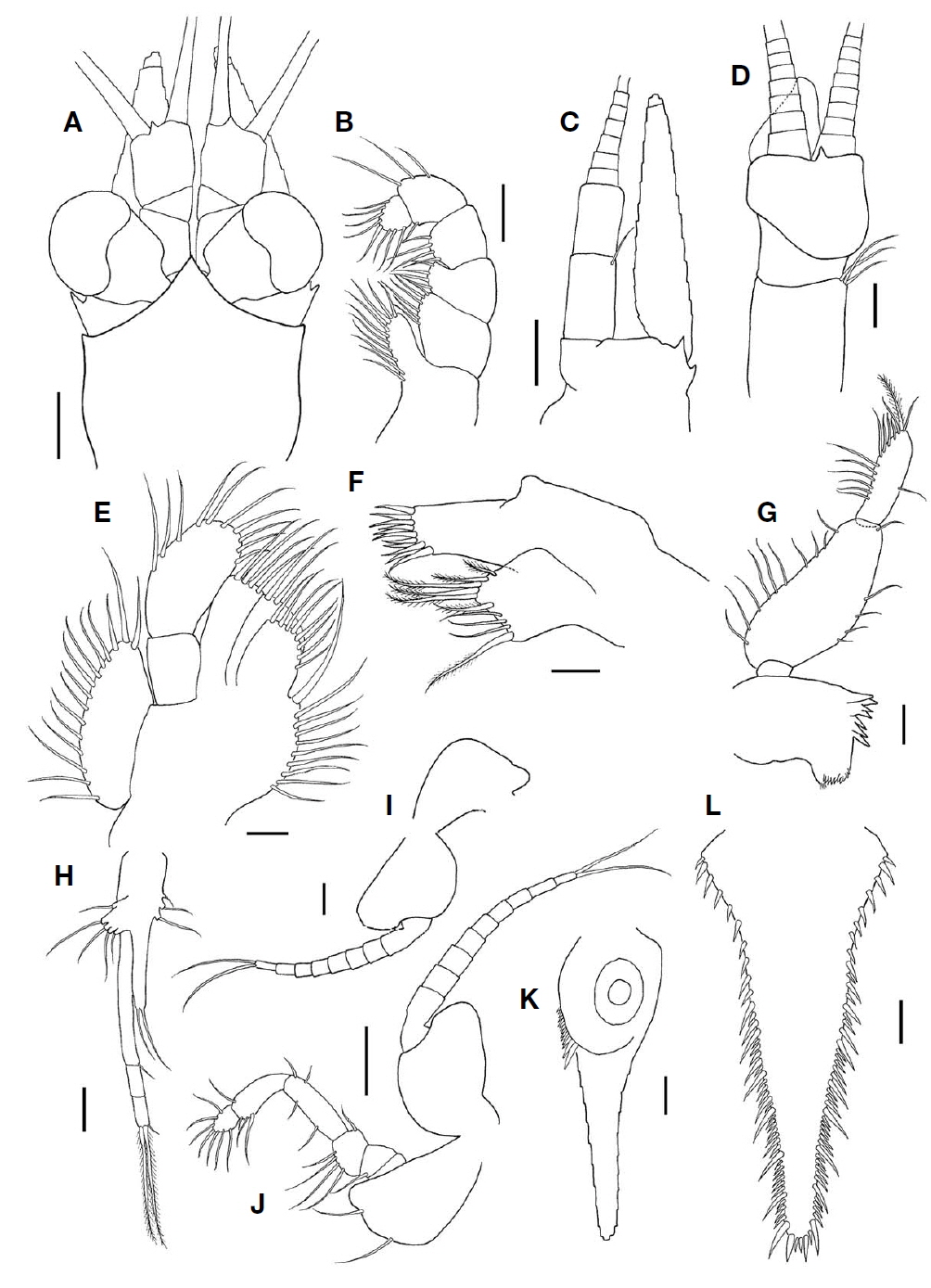



The genus
Jo and Jeon (2007) firstly reported three species belonging to the genus:
All specimens were collected with a light and bait trap equipment. The specimens were preserved in 70% ethyl alcohol and illustrations prepared using a drawing tube on a compound microscope equipped with differential interference contrast (Model BX-60; Olympus, Tokyo, Japan). Body length was measured from the tip of the rostrum to the distal apex of the telson excluding the spine. The simple setae and plumage of the plumose setae on the margin of antennules, antennae, mouthparts, and uropods are omitted from the figures. Terminology for the dissection and measurement is adopted from Tattersall and Tattersall (1951). All specimens have been deposited in the Marine Arthropod Depository Bank of Korea (MADBK), Seoul National University.
Order Mysida Haworth, 1825
Family Mysidae Haworth, 1825
Subfamily Mysinae Haworth, 1825
Genus Nipponomysis Takahashi & Murano, 1986
Material examined. Korea: 1♂, Gyeongsangnam-do, Namhae-gun, Sangju Beach, 30 Aug 2005, in light and bait trap; 1♂, Gangwon-do, Gangneung-si, Jumunjin Port, 10 Sep 2007; 8♂♂, 41♀♀, Gyeongsangbuk-do, Uljin-gun, Goljang Port, 37°01′54′′N, 129°24′32′′E, 19 Oct 2010, in light trap; 1♀, Uljin-gun, 36°59′51′′N, 129°24′18′′E, 24 Aug 2011, in light trap; 4♀♀, Chungcheongnam-do, Taean-gun, Anmyeon-eup, Seungeun-ri, 1317-15, 25 Nov 2011, in light trap; 1♂ 1♀, Gangwon-do, Samcheok-si, Wondeok-eup, Nogok-ri, Jakjin Port, 13 Oct 2011; Jejudo Island, Jeju-si, Hangyeong-myeon, 4♂♂, 2♀♀, 23 Sep 2011, in light trap.
Description. Carapace (Fig. 2A) with anterior margin produced into triangular rostral plate with pointed tip, reaching middle of first segment of antennular peduncle; posterior margin emarginated, antero-lateral corners rounded. Eye (Fig. 2A) normal; cornea reniform in dorsal view, occupying 1/2 of whole eye; eyestalk without denticles.
Antennal scale (Fig. 2B) lanceolate with round apex, about 4 times as long as broad; distal suture occupying about 1/18 of whole length of antennal scale; outer margin straight, inner margin concave, entire margin with setose. Antennal peduncle 3-segmented; second segment longest, 2.5 times as long as first; third segment 1.5 times as long as first one.
Antennular peduncle (Fig. 2C) 3-segmented; first segment longest, 2 times as long as second one and bearing three plumose setae; second segment shortest, about 1/2 of third one.
Mandibular palp (Fig. 2D) 3-segmented; second segment 2.5 times as long as third
Maxilla (Fig. 2E) armed with plumose setae along margin; endopod 2-segmented, second segment 1.5 times as long as broad.
Maxillule (Fig. 2F) with outer lobe bearing 8 robust setae on distal margin.
Endopod of first and second thoracopods (Fig. 2G, I) shown no marked difference from those in other species of genus.
Endopod of third to eighth thoracopods (Figs. 2H, 3A) with 3-subsegmented carpopropodus; proximal segment longest, remaining two segments equal in length; dactylus short and robust.
Inner uropod (Fig. 3B) with 9-11 spines in ventral statocyst region; outer uropod 1.1 times longer than inner uropod.
Telson (Fig. 3C) linguiform, about 1.5 times as long as broad; proximal half of lateral margin bearing 3-5 spines and remaining margin armed with series of spines which smaller 1-4 spines grouped between larger spines, larger spines increasing in length); apex truncated, armed with 2 pairs of spines, outer spines robust, 3 times as long as inner ones.
Distribution. Korea (East, South, and Yellow Sea), Japan.
Remarks. The specimens collected differ from those of other previous studies (Ii, 1936, 1964b; Takahashi and Murano, 1986). In the present study, the female rostrum of Korean specimens only extended to the middle of the first segment of the antennular peduncle. However, the original description of Ii (1936) noted that the rostrum extended to the distal end of the first segment of the antennular peduncle. Other differences were also observed by the following characters: 1) in our specimens, the ratio of whole length to proximal width of the antennal scale was 4 instead of 5 to 6 in previous records; 2) the ratio of the distal suture of antennal scale in the present specimens was 1/18 to 1/16, compared to 1/16 to 1/6 in previous studies.
To date, this species has been reported only from Japan, so this second description extends the geographical distribution westward. Additionally, this species is coastal form and inhabits littoral, as well as common among seaweeds (
Material examined. Korea: 1♂, Gyeongsangnam-do, Namhae-gun, Sangju Beach, 30 Aug 2005, with a light and a bait traps.
Description. Carapace (Fig. 4A) with anterior margin produced into triangular rostral plate with pointed tip, extending to base of antennular peduncle; posterior margin emarginated, antero-lateral corners rounded. Eye (Fig. 4A) normal; cornea reniform in dorsal view, occupying 1/3 of whole eye; eyestalk without denticles.
Antennal scale (Fig. 4C) lanceolate with round apex, about 5 times as long as broad; distal suture occupying about 1/20 of whole length of antennal scale; outer margin straight, inner margin concave. Antennal peduncle 3-segmented; second segment longest, 1.5 times as long as first; third segment slightly shorter than second one.
Antennular peduncle (Fig. 4D) 3-segmented; first segment longest, 1.7 times as long as second and bearing three setae; second segment shortest, about 2/3 length of third one.
Maxilla (Fig. 4E) armed with plumose setae along margin; endopod 2-segmented, distal segment about 2 times as long as broad.
Maxillule (Fig. 4F) with outer lobe along with 11 robust setae on distal margin.
Mandibular palp (Fig. 4G) 3-segmented; second segment 1.8 times as long as third.
Endopod of first, second thoracopods (Fig. 4B, J), and exopod of third to eighth thoracopods (Fig. 4I) shown no marked difference from those in other species.
Fourth pleopod (Fig. 4H) biramous; exopod 3-segmented, first segment elongate, 4.4 times as long as second one; third segment subequal in length to second one, with 2 strong spinose setae terminally; endopod unsegmented and rudimentary
Inner uropod (Fig. 4K) with 14 spines in ventral statocyst region.
Telson (Fig. 4L) narrowly long triangular, about 2 times as long as broad; proximal 1/3 of lateral margin bearing 8-9 spines and remaining margin armed with numerous series of spines which smaller 1-7 spines grouped between larger spines, increasing in length toward apex; apex truncated and armed with 2 pairs of spines, outer spines about 2 times as long as inner ones.
Distribution. Korea (South Sea), Japan.
Remarks. This specimen coincides with descriptions given by Ii (1940, 1964b) and Takahashi and Murano (1986) in general, except for following characters: 1) Ii (1940, 1964b) noted that the ventral inner margin of statocyst with 24 blunt spines compared to only 14 spines in the present specimen. Also, Takahashi and Murano (1986) recorded 21 spines by only showing the figures without descriptions. Secondly, Ii (1940, 1964b) described that the first and second segments of the exopod in male fourth pleopod are terminated by plumose setae on both inner and outer distal ends. On the other hand, presently there were no setae evident, which was badly damaged; 3) the entire whole length of the telson was 3 times as long as basal broaden part in the description of Ii (1940, 1964b), but 2 times as long as broad in the present specimen. Even with these minor differences, this specimen is identified as
Key to the species of
1. Lateral larger spines on telson subequal in size ∙∙∙∙∙∙∙∙∙∙∙∙2
- Lateral larger spines on telson gradually increasing in size toward distal end or distalmost larger spine markedly longer than the others ∙∙∙∙∙∙∙∙∙∙∙∙∙∙∙∙∙∙∙∙∙∙∙∙∙∙∙∙∙∙∙∙∙∙∙∙∙∙∙∙∙∙∙∙∙∙∙∙4
2. Telson linguiform, lateral margin with spineless part occupying 1/6 of its own length ∙∙∙∙∙∙∙∙∙∙∙∙∙∙∙∙∙∙∙∙∙∙∙∙∙∙∙∙∙∙∙∙∙∙∙∙∙ ∙∙∙∙∙∙∙∙∙∙∙∙∙∙∙∙∙∙∙∙∙∙∙∙∙∙∙∙∙∙∙∙∙∙
- Telson narrowly long triangular, lateral margin armed with spines throughout its entire length ∙∙∙∙∙∙∙∙∙∙∙∙∙∙∙∙∙∙∙∙∙∙∙∙∙∙∙∙∙∙3
3. In male, exopod of fourth pleopod with first and second segments armed with a pair of plumose setae, and second and third one subequal in length ∙∙∙∙∙∙∙∙∙∙∙∙∙∙∙∙∙∙∙∙∙∙∙∙∙∙∙∙∙∙∙∙∙∙∙∙ ∙∙∙∙∙∙∙∙∙∙∙∙∙∙∙∙∙∙∙∙∙∙∙∙∙∙∙∙∙∙∙∙∙∙∙∙∙∙∙∙∙
- In male, exopod of fourth pleopod with first segment about as long as the sum of second and third ∙∙∙∙∙∙∙∙∙∙∙∙∙∙∙∙∙∙ ∙∙∙∙∙∙∙∙∙∙∙∙∙∙∙∙∙∙∙
4. Telson elongate linguiform, about twice as long as broad, armed with 6-9 sets of grouped spines on lateral margin, lateral larger spines of telson subequal in size except that the distal most spine markedly longer than the other ∙∙∙∙∙∙∙ ∙∙∙∙∙∙∙∙∙∙∙∙∙∙∙∙∙∙∙∙∙∙∙∙∙∙∙∙∙∙∙∙∙∙∙∙∙∙∙∙∙∙∙∙∙∙∙
- Telson linguiform, 1.5-2 times as long as broad, armed with 4-6 sets of grouped spines on lateral margin, lateral larger spines of telson gradually increasing in size toward distal end ∙∙∙∙∙∙∙∙∙∙∙∙∙∙∙∙∙∙∙∙∙∙∙∙∙∙∙∙∙∙∙∙∙∙∙∙∙∙∙∙∙∙∙∙∙∙∙∙∙∙∙∙∙∙∙∙∙∙∙∙∙∙∙∙∙∙5
5. Rostral plate extending to distal end of first segment of antennular peduncle; proximal subsegment of carpopropodus of third to eighth thoracic endopods armed with setae ∙∙∙∙∙∙∙∙∙∙∙∙∙∙∙∙∙∙∙∙∙∙∙∙∙∙∙∙∙∙∙∙∙∙∙∙∙∙∙∙∙∙∙∙∙∙∙∙
- Rostral plate not extending beyond base of antennular peduncle; proximal subsegment of carpopropodus of third to eighth thoracic endopods armed with 4-5 spines ∙∙∙∙∙∙∙∙ ∙∙∙∙∙∙∙∙∙∙∙∙∙∙∙




